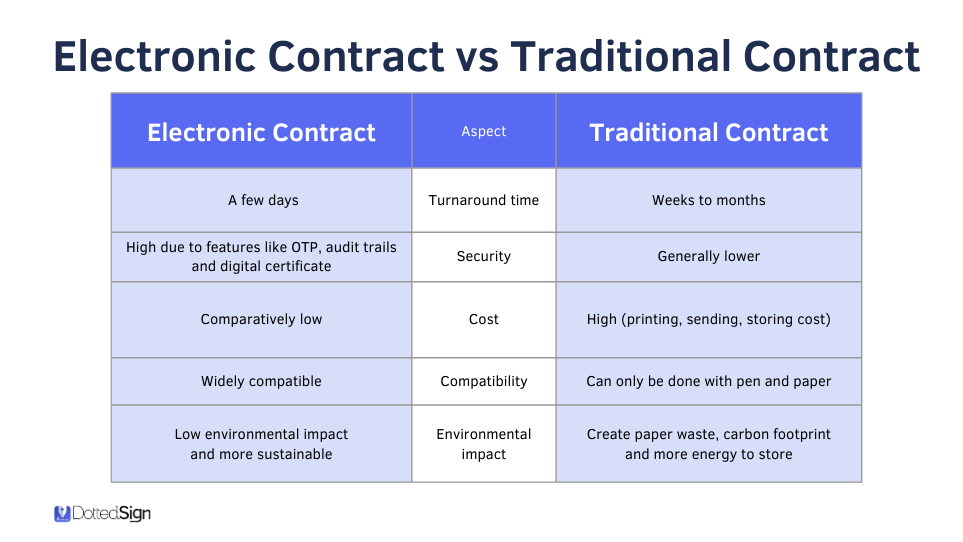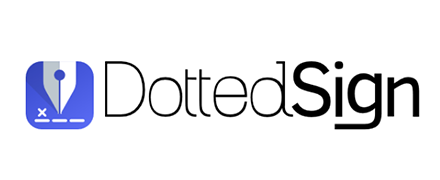Electronic Contracts vs Traditional Contracts:
An In-Depth Analysis
The formalization of agreements between people has changed significantly, with contracts as the basis for legally binding agreements. The emergence of electronic contracts lately brings a new format to this long-standing practice.
In this article, we’ll dive into the core aspects of traditional and electronic contracts, explaining their formation, legitimacy, and the myriad advantages that position electronic contracts at the forefront of the digital age.
Table of Contents
What is a Traditional Contract?
A traditional contract is a formal agreement documented on paper or agreed verbally, providing a tangible record of commitments between involved parties. Verbal agreements, however, can pose challenges in proving authenticity and legitimacy, so our focus in this article will be on contracts documented on paper. These contracts typically emerge from face-to-face discussions, manually written terms, and signed documents, encompassing crucial elements like the offer, acceptance, payment, legal competence, voluntary consent, and the arrangement’s legality.
Traditional contracts involve meticulous steps, including in-person meetings, negotiation sessions, drafting, and obtaining physical signatures. This method can be time-consuming, often requiring multiple rounds of discussions and manual efforts.
Legitimacy of Traditional Contracts
The legitimacy of traditional contracts depends on having a tangible, physical document. Signatures, often written in ink, symbolize commitment and authenticity. While laws and regulations vary globally, the reliance on a physical document remains a common thread in upholding the legality of traditional contracts.
What is an Electronic Contract?
Electronic contracts, or e-contracts, are created and signed digitally or online instead of on paper. Instead of signing physical documents, people can use electronic methods like emails or computer programs to make legally binding agreements. This shift from traditional to digital methods is driven by the desire for faster and more efficient processes in the modern era of technology.
Many freelance services and independent contractors now utilize digital signing platforms to formalize client service agreements and contracts securely. Rather than printing documents to be physically signed, both parties digitally sign off on the same standardized contract template, making the e-contract legally valid and enforceable with an electronic signature. This facilitates contract work across geographic distances more efficiently while retaining the formality and security of traditionally signed agreements.
Legitimacy of Electronic Contracts
The acceptance of electronic contracts is backed by laws that recognize their validity. Different countries have rules, like the Electronic Transactions Act, acknowledging electronic signatures and using electronic documents in courts. However, the level of acceptance can vary globally.
In the U.S., for instance, electronic signatures are governed by the United States Electronic Signatures in Global and National Commerce Act (E-Sign Act) and the Uniform Electronic Transactions Act (UETA), which was established in 2000. Similarly, in the U.K., the Electronic Communications Act of 2000 assures that an agreement or transaction is not invalidated simply because it was delivered electronically.
For a more detailed exploration of the legitimacy of electronic contracts, you can read our article: What Makes an Electronic Signature Legally Binding?
Sign Anytime, Anywhere
- Secure, legal, and reliable
- Effortless document signing
- Available on all devices
Capture Signatures with DottedSign!
Start NowComparison of Electronic Contracts and Traditional Contracts

1. Reduce Turnaround Time
Traditional paper contracts often require a lengthy turnaround, stretching over weeks or months. Electronic contracts cut down this time significantly, enabling swift signing and transmission via email and eliminating the necessity for physical prints or postal services.
A noteworthy instance of the benefits of electronic contracts is evident in the experience of CHIMEI Corporation. Before integrating electronic contracts through DottedSign, signing contracts with foreign manufacturers took 2-4 weeks. With DottedSign, the same task now takes just one day.
2. Fraud and Tampering Resistance
Unlike traditional contracts, which are vulnerable to fraud and tampering with easily compromised signatures, e-contracts provide features that establish a tamper-resistant and transparent transaction record.
Electronic contract solutions like DottedSign incorporate security measures, such as OTP (one-time password) verification, to verify the signer’s identity. Additionally, DottedSign’s digital certificates ensure the signing process occurs in a secure environment with robust encryption. Moreover, features like audit trails capture details such as the signers’ emails, IP addresses, all revisions, and timestamps, preventing tampering during the signing process.
3. Lower Management and Storage Cost
Traditional paper contracts need physical spaces to store and a system to manage them. Businesses not only have to spend money on keeping the paper contracts, but often, they also have to implement a system to help them search and manage the contracts later on.
Electronic contracts, on the other hand, don’t need physical space to store. Solutions like DottedSign can streamline this post-signing process from storing to managing. All signed documents will not only be sent automatically to all stakeholders but will also be archived in the DottedSign system. For small businesses, it can take a lot of financial weight off their shoulders.
4. Integration with Digital Assets and Services
Unlike paper contracts requiring in-person signing with a pen, e-contracts seamlessly integrate with digital assets and services, enabling adaptability to the ever-evolving (or ever-changing) digital landscape.
5. Reduced Environmental Impact
Electronic contracts eliminate the need for printing, postal services, or physical archiving, as every signing step can be completed digitally and stored in the cloud for easy access.
For industries burdened with paper-heavy workflows, achieving sustainability can be a challenge. Yet, in 2023, one of DottedSign’s clients, Lion Travel, successfully transitioned from paper agreements to electronic ones. Lion Travel estimates that if all its direct clients use DottedSign, it will save around 450,000 sheets of paper annually, equivalent to approximately 4.5 metric tons.
Electronic Contracts: The Future of Contracts in the Digital Age
As we navigate the digital frontier, electronic contracts are poised to redefine the future of contractual agreements. Their advantages regarding automation, security, transparency, and integration position them as powerful tools in the ever-evolving world of commerce.
While traditional contracts will always have their place, the efficiency and innovation in electronic contracts herald a new era in legal agreements. Adopting e-signature workflows further accelerates the electronic contract signing process, making it more efficient and seamless.
Embrace the future of contract management with DottedSign – a solution that not only streamlines the signing process but also enhances efficiency, reduces costs, and contributes to a more sustainable and eco-friendly business environment. Make the shift to electronic contracts today and experience the ease of modern business transactions.



